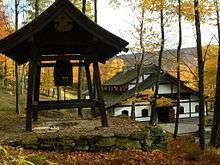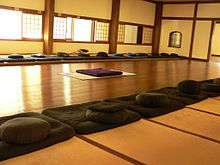Dai Bosatsu Zendo Kongo-ji
Dai Bosatsu Zendo Kongo-ji, or International Dai Bosatsu Zendo Kongo-ji, is a Rinzai monastery and retreat center located in the Catskill Mountains of upstate New York. Maintained by the Zen Studies Society, Dai Bosatsu Zendo Kongo-ji is led by Shinge-Shitsu Roko Sherry Chayat Roshi. It is part of the Zen Studies Society, founded in 1956 to support the work of D.T. Suzuki.
| Dai Bosatsu Zendo Kongo-ji | |
|---|---|
 | |
| Religion | |
| Affiliation | Rinzai |
| Location | |
| Location | 223 Beecher Lake Road, Livingston Manor, New York 12758-6000 |
| Country | United States |
| Architecture | |
| Founder | Soen Nakagawa Roshi & Eido Tai Shimano Roshi |
| Completed | July 4, 1976 |
| Website | |
| http://www.daibosatsu.org | |

Activities
The site offers daily services which include zazen, chanting and samu (work). Dai Bosatsu Zendo Kongo-ji also offers traditional kessei — a three-month period of intensive spiritual training in a Zen monastery — in addition to weeklong sesshins and weekend retreats throughout the year.[1] Those students who wish to ordain with Shinge Roshi must live at the monastery for 1,000 days, after which they have the option of staying or going back out into the secular world.
Location
Located about a 3-hour drive north of New York City on 1,400 acres (5.7 km2) near Beecher Lake[1] in a deciduous forest region,[2] Dai Bosatsu Zendo Kongo-ji was established on July 4, 1976.[3] The monastery site is located atop a 2-mile (3.2 km) drive that passes by "Sangha Meadow", a cemetery for housing the remains of deceased sangha members (including a portion of the ashes of Soen Nakagawa Roshi).[2] The facility's upstate mailing address is in the nearby township of Livingston Manor off New York State Route 17 (NY 17), and an active New York City temple is maintained on the upper east side of Manhattan.
Controversy
In July 2010, Eido Shimano, co-founder of Dai Bosatsu Zendo Kongo-ji and an abbot for over three decades, resigned from the Zen Studies Society Board of Directors after a relationship between Shimano and one of his female students became a subject of controversy, amid accusations that this was only the latest in a series of affairs spanning several decades. A committee of Zen teachers formed in November 2011 found that the sexual acts were often initiated during formal private sanzen interactions between Zen teacher and student.[4][5][web 1] The board was aware of the situation for decades, but was unsure how to respond."[6]
In December, 2012, Myoshinji, the headquarters of Shimano's claimed lineage sect, issued a public statement responding to the controversies surrounding Shimano and the Zen Studies Society; they state they have
...no connection with Eidō Shimano, his activities or organizations, including Dai Bosatsu Zendo and all affiliated Zen Studies Society institutions, nor is Eidō Shimano or any of his successors certified as priests of the Myōshin-ji branch of Zen or recognized as qualified teachers."[web 2][web 3]
See also
- Eido Tai Shimano (co-founder of DBZ and an abbott for over three decades)
- Buddhism in the United States
- Timeline of Zen Buddhism in the United States
- Sesshin
- Tenzo
- For an explanation of terms concerning Japanese Buddhism, Japanese Buddhist art, and Japanese Buddhist temple architecture, see the Glossary of Japanese Buddhism.
Notes
- Wilson, 146–147
- Keenan, xiii–xiv; 192
- https://web.archive.org/web/20080219114314/http://www.daibosatsu.org/dbzindex.html. Archived from the original on 19 February 2008. Retrieved 17 February 2008. Missing or empty
|title=(help) - "Sex Scandal Has U.S. Buddhists Looking Within". The New York Times. 21 August 2010.
- Adam Tebbe (16 February 2013). "Joshu Sasaki and the Challenge of Sex Scandals in the Zen Community". The Huffington Post.quote: The sexual encounters were often initiated in the sanzen room. Sanzen is a ritualized private meeting between a Zen student and Zen teacher."
- Oppenheimer, Mark (14 November 2013). "From Zen Buddhism to Preying on Vulnerable Women". The Atlantic. Retrieved 27 February 2017.
References
- "Archived copy" (PDF). Archived from the original (PDF) on 3 March 2016. Retrieved 11 February 2016.CS1 maint: archived copy as title (link)
- "About Myoshinji Temple". Myoshinji Temple. Archived from the original on 13 January 2013.
- "Sweeping Zen, Myoshin-ji announces "No connection with Eido Shimano or Zen Studies Society"". Archived from the original on 4 March 2016. Retrieved 11 February 2016.
- Fischer-Schreiber, Ingrid; Schuhmacher, Stephan; Woerner, Gert (1994). The Encyclopedia of Eastern Philosophy and Religion: Buddhism, Taoism, Zen, Hinduism. Shambhala Publications. ISBN 0-87773-980-3.
- Keenan, Terrance (2000). St. Nadie in Winter: Zen Encounters with Loneliness. Tuttle Publishing. ISBN 1-58290-071-X.
- Wilson, Jeff (2000). The Buddhist Guide to New York. Macmillan. ISBN 0-312-26715-0. OCLC 44089480.